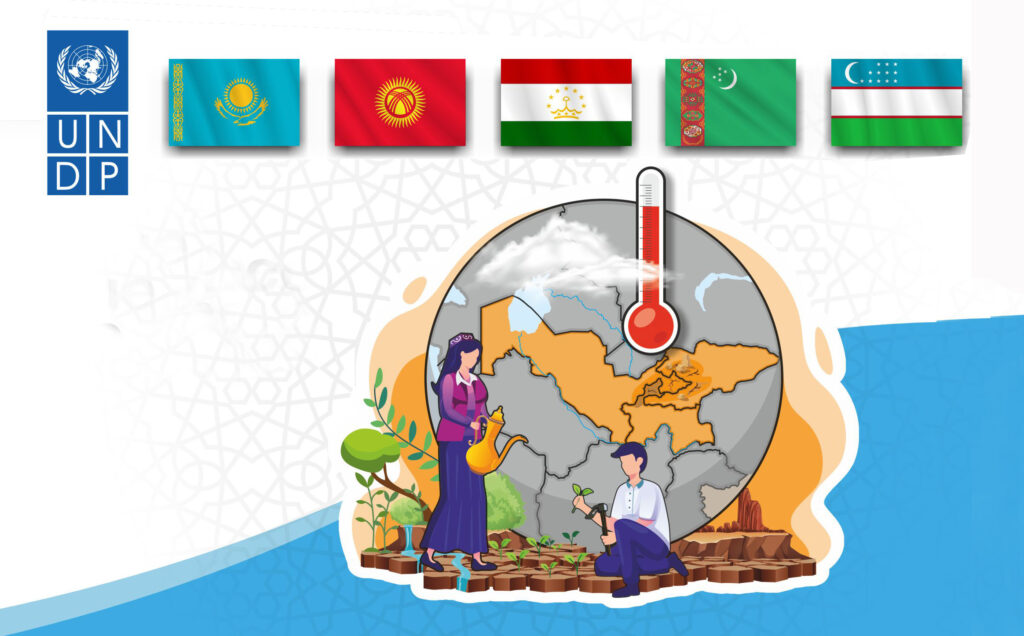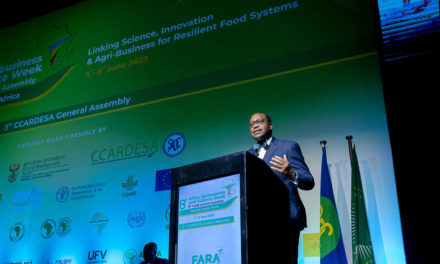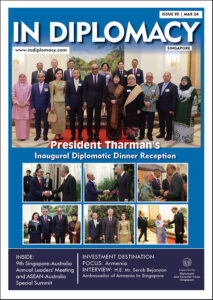
What are the prospects for international cooperation to ensure Central Asia, one of the most vulnerable regions of the world to climate change, can meet the challenges that lie ahead?
By Khoshimova Shakhodat and Oleg Limanov
CENTRAL Asia region is characterized by drought, sharp fluctuations in temperature and low precipitation, and heterogeneous distribution of resources, and is particularly vulnerable to climate change. According to the United Nations Development Program, the average annual temperature in Central Asia has increased by 0.5°C over the past 30 years and is projected to increase by 2.0-5.7°C by 2085. The increased frequency and speed of extreme weather events and natural disasters threaten physical security, critical infrastructure and access to health and education. Economic and social instability, low levels of research capacity, and high degradation of agricultural and natural landscapes also negatively affect the ability of Central Asian states to cope with climate change.
1. Climate and related water, energy and other problems have a serious negative impact on all countries in the region.
First, climate change has jeopardized water and energy security in Central Asian countries. Glaciers are shrinking (decreasing in size by 30% over the last 50-60 years), while the demand for water and energy in the region is growing. According to forecasts, by 2050 the population of Central Asia will increase from 77 million to 110 million people. According to FAO and World Bank experts, water resources per capita in Central Asian countries are sufficient (about 2.3 thousand meters3 ), and the problem in the region is not in their deficit, but in extremely irrational use. The availability of domestic renewable water resources in the downstream countries is weak.
This situation will be exacerbated not only by climate change, but also by growth in production, agriculture and population, which will increase the demand for water.
The Asian Development Bank (ADB) forecasts a 10-15% decrease in water volumes in the Syr Darya and Amu Darya basins by 2050. Rivers are the most important sources of water in Central Asia, which affects water scarcity in the countries of the region. The current water deficit in Uzbekistan may increase to 7 billion cubic meters by 2030 and to 15 billion cubic meters by 2050, taking into account the decrease of water volumes in the Syr Darya and Amu Darya basins.
As is known, the Aral Sea desiccation remains the biggest environmental problem in the region. The countries of the region have very poorly implemented water-saving technologies, coordination of management systems is limited, and a systematic approach to shared water networks, including smaller rivers and lakes, has not been realized. Against this background, more active work of international structures such as the International Fund for Saving the Aral Sea and the Interstate Commission for Water Coordination of Central Asia on the Aral Sea is needed.
Secondly, every year the countries of the region face drought, which reduces crop yields and in some cases leads to their complete destruction, thereby causing huge material damage to agriculture and becoming a cause of threat to food security of the entire region. Agriculture accounts for 10-45% of the GDP of CA countries. Agriculture employs 20-50% of able-bodied population, at the same time, according to FAO, more than half of rainfed arable lands in the region are regularly subjected to drought, and almost all irrigated areas experience high or very high levels of water stress.
Drought can also be caused by destructive sand and dust storms that can move billions of tons of sand across continents. Deserts expand, reducing the amount of land available for growing food crops.
Heat stress caused by high temperatures exacerbates water scarcity and reduces the amount of pasture, resulting in lower crop yields and adversely affecting livestock production.
Third, impacts on energy production caused by rising temperatures and decreasing precipitation, as well as threats to the infrastructure for power generation and transmission caused by extreme weather events, undermine the supply chain and energy security.
In Central Asian countries such as Kyrgyzstan and Tajikistan, where hydropower has a special place in the economy, siltation of reservoirs can reduce power generation and create additional difficulties for HPP management.
Overall, the World Bank estimates that negative climate impacts could lead to a 20% reduction in hydropower generation in Kyrgyzstan and Tajikistan in the coming years. Higher water temperatures or insufficient water could adversely affect thermal power generation in the rest of the region.
Fourth, the socio-economic consequences of climate change in Central Asia are explained by the financial losses caused by the increasing number and frequency of natural disasters in Central Asia, such as floods, landslides, avalanches, mudflows, sandstorms, and fires, causing huge material damage. According to the World Bank, in the five Central Asian states since 1991, floods alone have affected more than 1.1 million people and caused more than $1 billion in damage. Overall, natural disasters in the region cause losses of about $10 billion and affect the lives of nearly 3 million people annually.
Climate change accompanied by extreme weather events further exacerbates the factors influencing the growth of poverty. Natural disasters can forcibly displace low-income people. Floods, landslides and landslides destroy settlements and people lose their livelihoods. Extreme heat and water scarcity negatively affect crop yields and thus farmers’ incomes. In addition, according to a World Bank report, up to 2.4 million internal climate migrants may appear in Central Asia by 2050.
2. The efforts of the Central Asian states to address global environmental problems are closely linked to the UN activities in this area. All CA countries have signed and ratified the Paris Agreement, the largest multilateral climate change treaty currently in force, which aims to involve all states in a common process of ambitious efforts to combat climate change and adapt to its consequences.
The states of the region participate in all international conferences on environmental protection without exception and have acceded to virtually all UN environmental conventions. These include: Framework Convention on Climate Change; Convention on Biodiversity; Vienna Convention and Montreal Protocol on the Preservation of the Ozone Layer; Convention to Combat Desertification; Basel Convention on the Control of Transboundary Movements of Hazardous Wastes and their Disposal; Aarhus Convention on Access to Information, Public Participation in Decision-making and Access to Justice in Environmental Matters.
Central Asian countries have in recent years launched a number of initiatives aimed at attracting the attention of the international community to the environmental problems of the region.
These include the “International Decade for Action: Water for Sustainable Development, 2018-2028”, initiated by Tajikistan, and a new draft resolution entitled “Nature knows no borders: transboundary cooperation is key to the conservation and sustainable use of biodiversity”, proposed by Kyrgyzstan.
The need to take effective measures on adaptation to the consequences of climate change has made all key issues on the climate agenda a particularly high priority for Uzbekistan. Thus, thanks to Tashkent’s efforts, in 2018, the Multipartner Fund on Human Security for the Aral Sea Region was established under the auspices of the United Nations, which has become a reliable platform for practical assistance from the international community to the population of the region living in an area with a complex environmental situation. To date, the Fund has attracted $134.5 million of financial resources from donor countries.
An important achievement was the fact that in 2021, during the 75th session of the UNGA, a special resolution proposed by the President of Uzbekistan on declaring the Aral Sea region a zone of environmental innovation and technology was unanimously adopted, co-sponsored by about 60 states. During the 3rd International Forum “One Belt One Road” held in October this year. During the 3rd International Forum “One Belt, One Road” (OBOR) held in October this year, the Uzbek side proposed to create with the participation of leading companies from China and other foreign partners a special demonstration technology park in the Aral Sea region for the implementation of industrial and socially significant programs based on the wide introduction of “green” technologies. The leadership of our country also proposed to launch a scientific and information platform for the transfer of “green” knowledge and solutions on the basis of the International Innovation Center of Priaralie.
Uzbekistan on a permanent basis takes an active part in the annual meetings of the UN Framework Convention on Climate Change. During the 27th meeting, held in 2022, the Uzbek delegation advocated for consolidation of efforts in achieving carbon neutrality, promoting renewable energy, climate change adaptation projects, combating desertification and land degradation, introducing water-saving technologies and other climate actions in Central Asia.
Another significant aspect was that the UN supported Uzbekistan’s intention to hold the first International Climate Forum in Samarkand in spring 2024, dedicated to climate change issues, where it is envisaged to discuss opportunities for international cooperation on reducing risks and threats in the Central Asian region and issues of attracting climate finance. During the 78th session of the UNGA in September this year in New York, the President of Uzbekistan initiated the adoption of the UN General Assembly resolution “Central Asia Facing Global Climate Threats: Solidarity for Shared Prosperity” and proposed to discuss its main provisions at the Samarkand Forum.
The leadership of Uzbekistan also pays increased attention to the pairing of conceptual initiatives – the “Green Agenda of Central Asia” and the “Green Silk Road”. In this regard, speaking at the 3rd OSOP Forum, the President of the country Sh. Mirziyoyev proposed “to develop a full-scale Program of “green” development for practical implementation of key tasks: “green” transformation and digitalization of economic sectors; creation of sustainable infrastructure in transport and energy sectors; launch of “green” industrial capacities; poverty reduction and development of “smart” agriculture”.
In this context, the Uzbek side also proposed to establish a Green Finance Fund in our country, which will become an effective tool for mobilizing financial resources for the development of low-carbon economy and clean technologies, as well as the introduction of high environmental standards in the countries of Central Asia.
The above-mentioned initiatives of Uzbekistan contribute to increasing the participation of our country in ensuring climate sustainability in Central Asia, legitimize, support and strengthen the “green discourse” in the region and beyond, firmly positioning Central Asia as a significant participant in the process of institutionalizing international cooperation in addressing the pressing problems of climate change and environmental protection. They also clearly fit into the realization of the main goals and objectives of the Strategy on Transition of the Republic of Uzbekistan to a Green Economy for the period 2019-2030 adopted in 2019.
In general, recent years have seen an intensification of the contribution of Uzbekistan and other Central Asian countries in addressing the most complex issues related to minimizing the consequences and adaptation to climate change in the world and its individual regions. Moreover, as noted by World Bank experts in the “Country Report on Climate and Development” published in November this year, measures to adapt to climate change and decarbonize Uzbekistan’s energy-intensive economy can help achieve the country’s development goals and improve the well-being of its citizens.
About the authors: Khoshimova Shakhodat and Oleg Limanov are Chief Researchers of the Information and Analytical Center for International Relations under the Ministry of Foreign Affairs of the Republic of Uzbekistan
Article above contributed through the Embassy of the Republic of Uzbekistan, Singapore

















